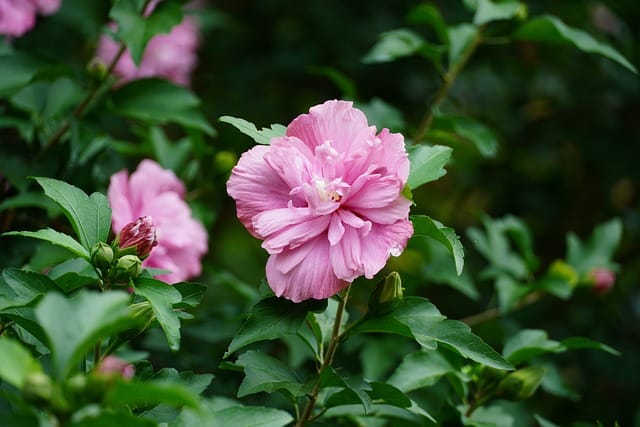How to grow Hibiscuses
Hibiscus flowers are known for their vibrant colors and beautiful blooms

In this article:
- Introduction to Hibiscus Flowers
- Selecting the Right Hibiscus Variety
- Preparing the Soil for Hibiscus Planting
- Planting and Transplanting Hibiscus
- Essential Growing Conditions for Hibiscus
- Watering and Fertilizing Hibiscus
- Pruning and Training Hibiscus Plants
- Dealing with Common Pests and Diseases
- Propagation Techniques for Hibiscus
- Overwintering Hibiscus Plants
- Popular Hibiscus Flower Varieties to Consider
- Tips for Displaying and Arranging Hibiscus Flowers
- Frequently Asked Questions about Growing Hibiscus
- Conclusion
Introduction to Hibiscus Flowers
Hibiscus flowers are known for their vibrant colors and beautiful blooms. They can be grown in gardens, pots, or as indoor plants, adding a touch of tropical beauty to any space.
Selecting the Right Hibiscus Variety
There are different varieties of hibiscus to choose from, including the tropical hibiscus (Hibiscus rosa-sinensis) and the hardy hibiscus (Hibiscus moscheutos). Depending on your climate and preferences, select a hibiscus variety that is suitable for your growing conditions.
Preparing the Soil for Hibiscus Planting
Hibiscus plants prefer well-draining soil that is rich in organic matter. Prepare the soil by adding compost or well-rotted manure to improve its fertility and drainage. Avoid heavy clay soils that can retain excessive moisture.
Planting and Transplanting Hibiscus
Plant your hibiscus in a sunny location, away from strong winds. Dig a hole that is slightly larger than the rootball of the plant. Place the plant in the hole, backfill with soil, and gently firm it around the roots. If transplanting, take care not to damage the roots and water the plant thoroughly after transplanting.
Essential Growing Conditions for Hibiscus
Hibiscus plants thrive in warm climates with temperatures between 60°F and 90°F (15°C - 32°C). They require at least 6 hours of direct sunlight daily. Ensure the plants are protected from frost and cold winds, as they are sensitive to low temperatures.
Watering and Fertilizing Hibiscus
Water your hibiscus deeply but infrequently. Allow the top inch of soil to dry out before watering again. Fertilize your hibiscus regularly during the growing season using a balanced fertilizer. Avoid over-fertilization, as it can lead to excessive foliage growth and reduced flowering.
Pruning and Training Hibiscus Plants
Prune your hibiscus regularly to maintain its shape and encourage more blooms. Remove dead or diseased branches, as well as any crossing or overcrowded branches. You can also train your hibiscus into a desired shape by pinching or pruning selectively.
Dealing with Common Pests and Diseases
Hibiscus plants are susceptible to pests such as aphids, whiteflies, and mealybugs. Keep an eye out for signs of infestation and treat them accordingly using organic or chemical solutions. Common diseases include powdery mildew and leaf spot, which can be prevented by providing adequate airflow and avoiding overhead watering.
Propagation Techniques for Hibiscus
Hibiscus can be propagated through seeds, cuttings, or layering. Each method has its own requirements and techniques. Experiment with different propagation methods to find the one that works best for you.
Overwintering Hibiscus Plants
In colder climates, hibiscus plants need protection during winter months. Bring potted plants indoors or provide a layer of mulch around the base of the plant in garden beds to insulate the roots. Reduce watering during the dormant period.
Popular Hibiscus Flower Varieties to Consider
Some popular hibiscus varieties include "Flamenco Dancer," "Tahitian Sunset," and "Double Delight." Research different varieties to find the one that suits your taste and growing conditions.
Tips for Displaying and Arranging Hibiscus Flowers
Showcase your hibiscus blooms by arranging them in vases or creating elaborate floral displays. Cut the flowers early in the morning, choose buds that are just about to open, and place them in fresh water to maximize their vase life.
Frequently Asked Questions about Growing Hibiscus
Q: When is the best time to plant hibiscus?
A: The best time to plant hibiscus is in spring when the temperatures are consistently above freezing and the risk of frost has passed.
Q: How often should I fertilize my hibiscus?
A: Fertilize your hibiscus every 4-6 weeks during the growing season with a balanced fertilizer.
Q: Can I grow hibiscus indoors?
A: Yes, certain varieties of hibiscus can be grown indoors as long as they receive adequate sunlight and are placed in well-draining pots.
Conclusion
Growing hibiscus flowers can be a rewarding and enjoyable experience. By providing the right growing conditions, taking care of pests and diseases, and implementing proper pruning and training techniques, you can enjoy the vibrant blooms of hibiscus in your garden or home. Experiment with different varieties and share your hibiscus-growing journey with others who appreciate the beauty of these tropical flowers.
